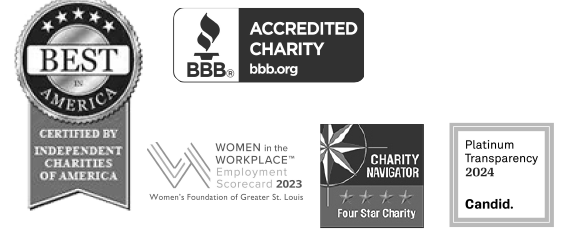Once a semester, students of Public Health from St. Louis University have the opportunity to observe Cooking Matters classes. Each student writes a reflective essay, applying Public Health concepts to what they witness in the Cooking Matters. Below are excerpts from one student’s reflections.
My family has never been one for the preparation of organic, natural foods. My mother tried to prepare meals for us, but extraneous health and financial problems interfered. We gravitated towards quick and easy meals—majority frozen and processed. Despite our struggles, my sister and I crossed over into adulthood with the knowledge of the importance of homemade meals. However, the financial struggles of each member of my family continue to this day, tenfold of what they were when I was a child. When granted the opportunity to choose a site for participant observation, I wanted to choose something with a message that would be beneficial to me in light of my past. When I chose to visit a Cooking Matters for Parents class at Crisis Nursery, I did not know what to expect outside of the generalized description– I knew that it taught people how to make healthy meals on a limited budget. I hoped to learn something new to pass on to my family.
My shadowing partner and I arrived shortly before class started. We navigated to the back of the building and rang the doorbell for the nursery. The door was opened by a petite blonde woman who appeared to be about our age. She introduced herself as Leslie Bertsch—the very woman with whom we had been in correspondence. She led us to a room filled with tables and cheap plastic folding chairs. The right side of the room opened up to a full kitchen. There were seven women and one male sitting at tables that were set up in a ‘U’ shape that faced an easel with a picture of “MyPlate,” showing the five food groups and healthy portions of each.
The volunteers/instructors and participants were friendly and welcoming. The class began with a question to the participants: Do you read food labels when purchasing food items at the grocery store? One or two of the participants noted their attempts. The instructors explained the concepts of serving size, servings per container, and whole grain/fiber. The class style allowed for participants to ask questions and talk about personal experiences.
The instructors talked about the different types of sugars. Many participants felt that some sugars were healthier than others. The instructors cut in to tell the group that “sugar is sugar” and then went on to explain the concept of starch and fiber as complex sugar. There were times that the instructors had difficulty in moving on to new topics because of the side commentary from the participants. However, the relaxed atmosphere allowed participants the courage to ask questions, both simple and complex, that would have otherwise been left unasked. For example, participants asked about the difference between fresh, canned, and frozen vegetables on a nutritional level. The style of the class ultimately allowed for participants to learn and gain insight from their peers as well as from the instructors.
The participants then broke down into teams and prepared turkey tacos and mango salsa and then sat down together to enjoy the product of their labor. The instructors/volunteers surprised me with a plate of food! We had the opportunity to sit down and talk to the participants about their experience in the class.
The second visit was much like the first—There were more exercises on the identification of serving size, sodium, trans fat, sugar, and saturated fat on food labels. The participants were given empty drink bottles, cups, and measuring devices and were asked to measure how much sugar was in their drink. The group was both amazed and horrified—a few people took photos of the cup of sugar to bring home and show their family members. Many participants verbalized their intention to cut down on soda. The group was asked about their personal application of skills learned during the class. Participants were able to voice their struggles, concerns, and victories. The group also broke down “MyPlate” and were asked about the contents of their plates at home. At the end of the class participants made tilapia and sweet potato fries.
Cooking Matters provides an educational service on nutrition and cooking to individuals who would otherwise not have access. In this respect, it embodies the public health core functions of policy development and assurance. The program informs, educates, and empowers parents to purchase and prepare healthful meals and instills the importance of meals prepared at home. Various presentations I have seen throughout the semester have educated me on the existence of food deserts in North City. Part of this education has focused on the fact that the lack of nutrition in these economically depressed areas is not solely due to lack of access to healthy foods. Cooking Matters introduces families to quick, healthy, and inexpensive meals by providing recipes and instruction to help break down barriers. The program links families to the educational opportunity provided by Cooking Matters by assuring that qualified individuals have access. This is done through the provision of ingredients to allow participants to practice the meals at home with their families. Participants that make it to the end of the program without missing more than two of the sessions get cookbooks and cooking gear provided by Share Our Strength.
Cooking Matters employs proven constructs/theories to positively affect the lives of the participants and their families utilizing a fun, educational, and attainable method. Prior to this course on behavioral science, I would have failed to identify the methods being used. I would have seen the work the organization performs and known that it was beneficial to society, but I would not have understood why the program functions as it does. There is a method and proven science to the ‘recipe’ of the program. Cooking Matters combines education, practice, reinforcement, and incentives in a way that builds up the self-efficacy of the participants. The mothers and fathers in the program leave with more knowledge, guidance, skill, and increased capacity that both enables and motivates the participants to continue practicing beyond the confines of the class. I am able to conceptually see how the program radiates out beyond the participants and benefits the communities it touches.
Overall, my experience with Cooking Matters exceeded my expectations. I envisioned a dry instructional on inexpensive healthy food items and recipes. I did not think about the connection to No Kid Hungry or the implications and waves the program could make throughout families and the community. By providing ingredients and actual practice the program breaks down barriers and increases the self-efficacy of the participants. The program has a strong linkage to social justice by affording the participants the opportunity to gain knowledge and skills that might have been neglected through generations due to impoverished school districts and lack of access to fresh fruits and vegetables. After my completion of the observation, I accessed the program website to collect recipes to try and to pass on to my family. I made the turkey tacos for my boyfriend and myself and hope my parents comply and try them as well. Everyone—no matter your race, ethnic group, age, sexual orientation, class, or background—deserves the knowledge, skill, and opportunity to live a healthy life. Though I cannot see the long-term effects, it is obvious that the knowledge and skills developed will continue to benefit the lives touched by the program.


